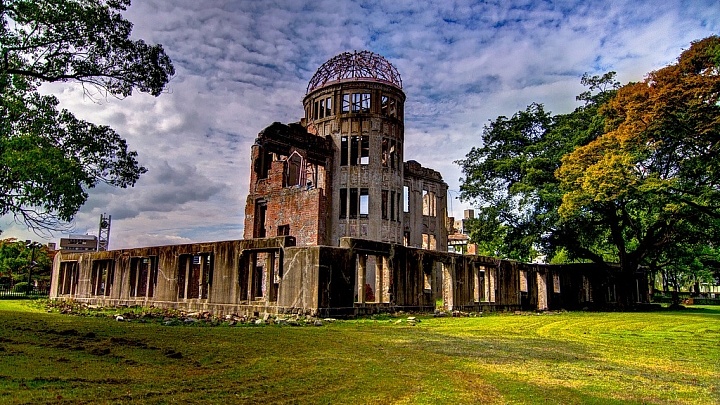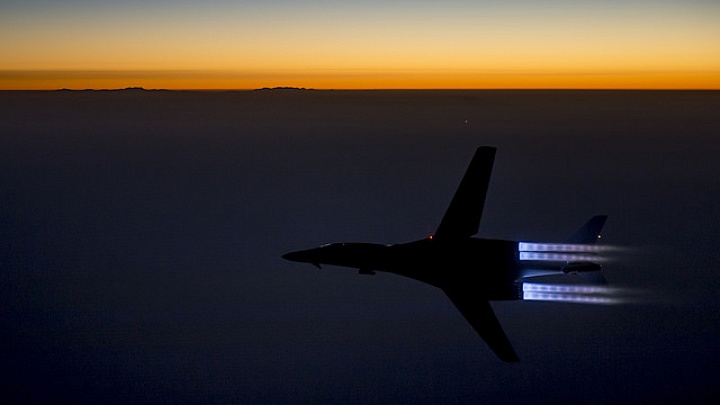
The Nuclear Non-Proliferation Treaty (NPT) recognizes only five “nuclear states” – the U.S., UK, France, Russia and China. Since 1967, India, Pakistan, North Korea and Israel have also developed nuclear weapons, almost doubling the size of the group. South Africa stands alone as the only country to have developed atomic weapons and then give them up. While the number of nuclear states has increased, there has been a slow, steady reduction of the number of nuclear warheads in the world to between 10,000 and 25,000, with, according to some, 90% of nuclear warheads produced since 1945 now out of service. Nonetheless, there are still more than enough serviceable warheads to destroy human civilization as we know it. We live in a world with an increasing number of nuclear states, but the picture is not as bleak as it may seem. President John F. Kennedy predicted that by 1964 the world would see as many as 10 to 20 nuclear powers. There is not that many today over 50 years later. World leaders have shown renewed interest in nuclear disarmament since 2007. With a practical view of nuclear disarmament, proper control, verification and enforcement mechanisms, and the necessary political will, it may be possible to achieve a nuclear weapons-free world. However, would such a world actually be any more secure?
Abolition v. Disarmament
Michael O’Hanlon points out an important difference in vocabulary in what one means by “a world without nuclear weapons.” “Abolishing” nuclear weapons means not only dismantling all existing weapons, but outlawing their testing, use, reconstruction, development, proliferation and make them wholly illegal in all circumstances. This differs from “disarmament”; dismantling or demilitarizing all currently existing nuclear arsenals in the world and agreeing an international framework to monitor progress and fissile materials, verify disarmament and mediate disputes, but not totally outlawing them forever in all circumstances. Both would constitute a “nuclear weapons-free world”, but disarmament is more realistic and achievable.
The NPT attempts to prevent nuclear proliferation and elicits an agreement in Article VI from nuclear states to cease the nuclear arms race, dismantle their nuclear weapons and agree a treaty leading to “general and complete disarmament” under international control – something they have yet to do. Article I stops nuclear states from transferring nuclear weapons technology to non-nuclear states while Article II prevents signatories which did not already possess nuclear weapons from obtaining them. States which have developed atomic weapons after the NPT have done so as non-members of the treaty. The NPT does not seek to abolish nuclear technology in the world. It recognises at Article I the right of nuclear states – America, Britain, France, China and Russia – to possess them. NPT Article IV in fact recognizes and encourages the development and sharing of the “inalienable right” to peaceful nuclear technology among nuclear and non-nuclear states – something often forgotten in debates about the nuclear ambitions of states such as Iran.
Individuals and groups who call for the abolition of nuclear weapons stand on firm moral ground. However, groups such as Greenpeace and iCan focus on campaigning to motivate individuals at grassroots level to apply pressure on officials to abolish atomic weapons, which, while also an important part of the effort, does not address the perennial underlying political and security issues which cause states to cling to or seek to acquire nuclear weapons. These groups have been critical of the 1970 NPT as legitimizing a system of nuclear “haves and have-nots” by giving special recognition to the five original nuclear states charge it has been ineffective in applying pressure to disarm and point to a complete ban on nuclear weapons along the same path as treaties for landmines and biological weapons as a better goal. Nonetheless, even some critical of the NPT and piece-meal bilateral agreements acknowledge that forever “dis-inventing” nuclear weapons is not possible and that if one state reconstitutes a nuclear program, there may be no alternative but for others to do so to confront that threat.
Control, Verification and “Virtual Deterrence”
In considering whether a nuclear weapons-free world is possible it must also be considered how any nuclear disarmament agreement, once reached, would be verified, how fissile materials would be controlled and how noncompliance would be confronted. An agreement without such teeth would be doomed from the start. Tracking and controlling nuclear material is the only way to ensure new atomic weapons cannot be developed. However, environmental, market and economic pressures have brought about the need for energy from a clean, reliable source such as nuclear power. The IAEA itself has called for 1,400 new nuclear reactors to be built worldwide by 2050 to meet world energy demand.
Counterintuitively, none of the nine states known to possess nuclear weapons is currently subject to IAEA inspections. The five NPT nuclear states are exempt and four non-NPT states – India, Israel, Pakistan, North Korea – are not subject to them. This means the overwhelming bulk of nuclear weapons and material in the world is only tracked by these governments. We all have to take their word for it. Any comprehensive treaty would have to include control, verification and inspection measures by an organization, such as the IAEA, which apply to all countries equally. The IAEA, “should be given the authority to inspect any facility, at any time, and anywhere on the territory of every signature state.”
Nuclear weapons technology cannot be dis-invented and the threat will always exist. Nuclear disarmament is possible; abolition of nuclear weapons forever is not
Even if all nuclear weapons are demilitarized, fissile material closely controlled and an inspection regime instituted, there will always be the chance that one or more states will reconstitute nuclear weapons at some point in the future. The first steps could be similar to those taken today against states such as North Korea and Iran – sanctions, negotiations and the thinly veiled threat of military action. However, such a process may take too long to stop or do nothing to prevent the reconstitution of nuclear weapons. Allowing it to be subject to a UN Security Council veto could further complicate matters. The fear a foe would secretly maintain nuclear weapons or rebuild them is an obstacle to convincing current nuclear-armed states to agree to give them up.
The concept of “virtual deterrence” has been put forward both to calm the security fears of current nuclear states regarding disarmament and as an enforcement and deterrence mechanism against rogue states that would start or reconstitute a nuclear weapons programme after achieving nuclear disarmament. Briefly, the idea is that current nuclear states, such as the P5, could maintain the threshold ability to reconstitute their nuclear programmes in a matter of months in such circumstances in order to confront the threat. Nuclear abolitionists would object, of course. However, nuclear weapons technology cannot be dis-invented and the threat will always exist. Nuclear disarmament is possible; abolition of nuclear weapons forever is not.
Political Will
In 2007, U.S. senior policy leaders Henry Kissinger, Sam Nunn, William Perry and George Shultz breathed new life into the movement toward “Global Zero” beginning with a series of opinion pieces in major American newspapers as part of the Nuclear Security Project. They succeeded in making nuclear disarmament an issue in the 2008 U.S. presidential campaign, supported by both then-Senator Barack Obama and Senator John McCain.
As President, Barack Obama named nuclear disarmament one of the priorities of his administration and promised in his 2009 Prague Speech that America would take “concrete steps toward a world without nuclear weapons.” In October 2009, President Obama was awarded the Nobel Peace Prize for his commitment to eliminating nuclear weapons. In April 2010, the U.S. Department of Defense released a Nuclear Posture Review (NPR) in which it reiterated America’s commitment to the elimination of nuclear weapons, committed to “reducing the role of U.S. nuclear weapons in U.S. national security strategy” and to “maintaining strategic deterrence and stability at reduced nuclear force levels” as key priorities. In April 2010, President Obama also signed New START with Russian President Dmitry Medvedev, reducing and limiting both nuclear arsenals to 1,550 warheads and between 700-800 delivery platforms. In May 2010 the 5-yearly NPT review conference was held in New York. The final document included recommitment of members to the NPT, specific action-plans regarding nuclear disarmament and proposed steps for creating a “WMD-free” zone in the Middle East. The U.S. National Security Strategy, released in May 2010, also reiterated U.S. commitment to ‘pursue the goal of a world without nuclear weapons’ and strengthening the NPT.
These events of the past nine years have shown a renewed commitment on behalf of most of the major nuclear states to nuclear disarmament, but it has not all been easy or good news. The U.S. and Russia did sign New START in 2010, though it was only just barely ratified by Congress in 2011 over objections by hawkish Republican Senators, such as John McCain who had had claimed to support nuclear disarmament in his 2008 presidential campaign. After agreeing a 2008 deal with the P5+1 to end its nuclear program, North Korea destroyed the cooling tower of its nuclear facility at Yongbyon. However, it appears to have restarted work at the facility in recent years and last month the North claimed to have tested a hydrogen bomb, though this is disputed by several intelligence agencies.
The political will is there, but the attention and timing must also be there and they all must coincide in order for there to be any realistic chance of achieving a world free of nuclear weapons
The renewed push for nuclear disarmament since 2007 has been overtaken by other domestic and international events in key states. The 2008 economic downturn, economic crises in EU states, government austerity policies in the UK, fights over tax and fiscal policies and domestic political issues such as Obamacare, sequestration and the debt ceiling, as well as international crises such as the Russian invasion of Ukraine and the Syrian Civil War and ensuing refugee crisis continue to absorb much of the world’s political energy and capital. Since 2008 there have been changes in national leadership in the U.S., UK, France, Russia, China, North Korea, India, Pakistan and Israel – every nuclear state.
The 2012 conference called for in the 2010 NPT review to devise a WMD-free zone in the Middle Eastwas canceled as it was unclear whether Israel, having just begun a military incursion into Gaza, or Iran would fully participate and Arab states were angered by further delays in a discussion which began 15 years before at the 1995 NPT review. The reinvigorated campaign for nuclear disarmament shows that the political will to push forward the agenda for a nuclear-free world exists; however, it is also constantly being stretched to the limit and attention is divided by other world events. Timing is crucial on this issue and real progress may not be possible until some of the world’s other major problems which often cause security concerns which complicate the nuclear disarmament issue are resolved first. As President Obama acknowledged in his 2009 Prague Speech, “This goal will not be reached quickly – perhaps not in my lifetime. It will take patience and persistence. But we, too, must ignore the voices who tell us the world cannot change.” The political will is there, but the attention and timing must also be there and they all must coincide in order for there to be any realistic chance of achieving a world free of nuclear weapons.
But Do We Really Want a World Free of Nuclear Weapons?
Though the accepted dilemma seems to be how to achieve a world free of nuclear weapons and whether it is possible, there is not much in-depth discussion as to whether a nuclear weapons-free world would provide security and peace as asserted. Arguably the most famous analysis of this question is the debate in book form between Scott Sagan and the late Ken Waltz.
Briefly, as a Realist, Waltz believed that the world consists of states in global anarchy which must find ways to create security for themselves through the two separate ideas of defence – the ability to repel an attack – and deterrence – the ability to inflict enough punishment on an opponent to create a disincentive for them to attack. Simply put, possession of nuclear weapons greatly bolsters a state’s ability to defend and deter and when two nuclear states stand opposed to one another, these weapons have an equalizing effect which causes them to proceed in a much more considered manner because of what they risk in a nuclear exchange and the knowledge that the other side, rationally, must be proceeding in the same manner creates a more secure condition. He asserts nuclear weapons allow states to meet the need to provide their own security and secure states do not fight wars. When confronted with the question if Global Zero would be better, Waltz answers that, “Abolishing the weapons that have caused sixty-seven years of peace would certainly have effects. Such an action would, among other things, make the world safe for the fighting of World War III.” Since what Robert Jervis termed the “Nuclear Revolution” of 1945, there certainly has been no large-scale conventional war between great powers.
Also briefly, Sagan responds to Waltz by arguing that nuclear weapons make the world less secure because they are military objects and, institutionally, military organizations are concerned with achieving “military victory” by defeating opponents in war. Because nuclear weapons provide unmatched potential to do that, military organizations will always seek to obtain advantage by building more nuclear weapons and will, as all institutions do, seek ever more resources to do so. Many states do not have sufficient civilian control over their military apparatus to counter these tendencies. More states will seek nuclear weapons and states that already possess them will build more, the end state being that they will not provide security for anyone, just more nuclear weapons. This creates a dangerous spiral. He also shows empirically that political and military leaders cannot always be counted on to act rationally in the severe emotional circumstances high-level conflict creates. On the question of Global Zero, Sagan answers that the need for nuclear deterrence ended with the Cold War and the threat of loose nuclear weapons falling into the hands of terrorist organizations is greater because they do not fear nuclear retaliation, making the need to reach zero a pressing modern issue.
As the title of their book suggests, this is An Enduring Debate. The world was a violent place before nuclear weapons and will still be one if ever we are without them, as Sagan recognizes, and still be fraught with conflict and the state quest for security, as Waltz asserts. Unless and until the world arrives at that point, there can be no answer.
[Photo: Flickr CC: Freedom II Andres]

